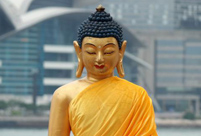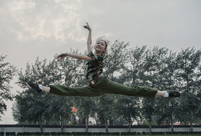 Vintage cars show kicks off in London
Vintage cars show kicks off in London
 Gorgeous scenery in NE China
Gorgeous scenery in NE China
 Picturesque Barkol grassland in Xinjiang
Picturesque Barkol grassland in Xinjiang
 Small Wild Goose Pagoda - A World Cultural Heritage Site along the Silk Road
Small Wild Goose Pagoda - A World Cultural Heritage Site along the Silk Road
 Maritime Silk Road Luxuries of the Han Dynasty
Maritime Silk Road Luxuries of the Han Dynasty
 Ciao! Chinese beauties!
Ciao! Chinese beauties!
 An eye feast: BFA freshmen registration
An eye feast: BFA freshmen registration
 Top 10 most lavish weddings
Top 10 most lavish weddings
 Most amazing chi-pao beauties
Most amazing chi-pao beauties
 Chinese lingerie brand arrives in Las Vegas
Chinese lingerie brand arrives in Las Vegas
The poster of Wolf Totem (Photo/China Youth Daily)
The grasslands on a stormy night, a lone herdsman on the pasture, and an alert wild wolf - the images create an atmosphere of suspese even on the posters promoting Wolf Totem.
Wolf Totem, a film co-produced by China and France, is releasing its posters, trailers and tasters. The film is scheduled for worldwide release at the end of 2014 and has ambitions to carry China to a shock 2015 Oscar for best foreign film.
Based on the Chinese writer Jiang Rong's semi-autobiographical and bestselling novel of the same name, this film discusses the relationship between human beings and nature in the name of environment protection.
Annaud shares similar experience with the protagonist
The novel, published in China in 2004, tells the story of a young student sent from Beijing during the Cultural Revolution to work as a shepherd in the countryside of Inner Mongolia, where he encountered wolves in the wild.
Making a film that puts a group of real wolves among human beings was deemed too difficult by many when the project was launched eight years ago, says Zhang Qiang, vice president of state-run China Film Group, which is in charge of the film’s production and distribution in China.
"I talked to almost all the prominent Chinese directors, but I got the same reply—that they loved the novel but could not make it into a movie," he said.
But French director Jean Jacques Annaud declined the offer from Hollywood to direct “Life of Pi”, instead choosing to make a trip to China to look at making the movie Wolf Totem in 2008 after the publication of French version of the book.
Annaud shares similar experiences with the young man in the novel. Annaud was sent to Cameroon on military service after he graduated from college. The novel is about change and growth and Annaud can see himself in the book.
Real wolves showcased in film
In contrast with The Warrior And The Wolf and The Grey, which relied heavily on computer-generated imagery, the crew raised a dozen newborn baby wolves at four bases in Inner Mongolia and Beijing and trained them for the movie for more than three years in order to build an emotional connection with them
Although the crew's security work was in accordance with international standards, the staff were faced with riskes every day. Feng Shaofeng, a leading actor in the movie, was injured by a wolf.
Shooting for the film took place in Inner Mongolia and lasted over a year, with the crew enduring constant attacks by mosquitos and capricious weather. Heedless of the harsh conditions, the 70-year-old director walked more than 10 kilometers each day for the sake of environmental protection.
Furthermore, the crew was extreme considerate with the wolves, which were allowed to take a rest every an hour. Annaud made every effort to protect the wolves from any injury, as he had no substitutes.
It was a challenge for Annaud to communicate with the wolves. But he jokes that it was easier to deal with these "actors" - "I didn't have to call their agents, like Hollywood superstars!"
During the shooting, many staff members and actors built close relationships with the wolves. Feng took care of newborn wolves with training groups, cutting meat for them. Annaud was proud of that he was privileged to kiss the wolf king.
Environmental concern
The novel aroused enormous controversy at the time of its publication. It has been a bestseller for 10 years. Pan Shiyi, a Chinese business magnate, anticipated that the movie will be much more influential than the novel.
It was the environmental aspect that attracted Annaud to the film. "China is not the only country faced with environmental issues. So are the U.S. and Europe. I am pleased to work with people aiming to improve environment," he says.
The crew of the movie were careful to protect the ecology of the grasslands in Inner Mongolia.
The article is edited and translated from《<狼图腾> 打“狼”牌探讨人与自然》, source: China Youth Daily, author: Wu Xiaodong
 |
 Mixed reaction to smartphone sidewalk
Mixed reaction to smartphone sidewalk 'Rainbow running' race in Jiangxi
'Rainbow running' race in Jiangxi Tourists float with lotus in park in Taipei
Tourists float with lotus in park in Taipei Amazing aerial photos of China's Xisha Islands
Amazing aerial photos of China's Xisha Islands Chinese Buddhist Canon blesses Hong Kong
Chinese Buddhist Canon blesses Hong Kong Beautiful postgraduate teaches in remote area
Beautiful postgraduate teaches in remote area Amazing Guinness World Records
Amazing Guinness World Records Freshmen of Beijing Dance Academy take military training
Freshmen of Beijing Dance Academy take military training Top 10 world's highest-paid models 2014
Top 10 world's highest-paid models 2014 Lingerie show at 2014 Miss China
Lingerie show at 2014 Miss China Songstress Li Xianglan dies at 94
Songstress Li Xianglan dies at 94 Police recruiting posters
Police recruiting posters Anshun Daxi- Living fossil of Chinese drama
Anshun Daxi- Living fossil of Chinese drama Urban farmers in China
Urban farmers in China 'Firepower-2014 Weibei'military exercise
'Firepower-2014 Weibei'military exerciseDay|Week|Month